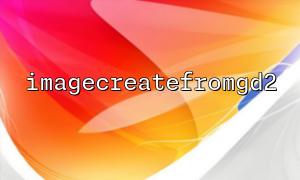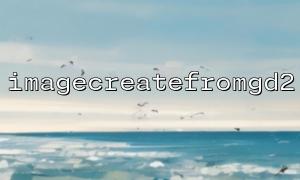PHP provides many functions for image manipulation, and the imagecreatefromgd2 function is one of them. It allows you to create an image resource from a GD2 image file. By combining the header() and imagejpeg() functions, you can directly output GD2 images and even embed them into web pages without needing to save the image on the server.
GD2 is an image format used by the GD graphics library for storing and processing image data. The GD library supports multiple image formats, such as JPEG, PNG, GIF, etc., and GD2 is a specialized binary image format. With PHP's GD library, you can create and manipulate various types of images.
imagecreatefromgd2 is a function in PHP used to load GD2 image files. The syntax for this function is as follows:
resource imagecreatefromgd2 ( string $filename )
$filename: The path to the image file.
Return value: Returns an image resource on success, or FALSE on failure.
header() is used to set HTTP header information, ensuring that the browser can correctly recognize the image type. For example, we can use it to specify the MIME type of the image as image/jpeg.
imagejpeg() is used to output the image resource as a JPEG image.
Below is an example demonstrating how to use imagecreatefromgd2, header(), and imagejpeg() to directly output a GD2 image to the browser:
<?php
// Set the correct HTTP header information to inform the browser that the content is an image
header('Content-Type: image/jpeg');
<p>// Create an image resource from the GD2 format image file<br>
$image = imagecreatefromgd2('path/to/your_image.gd2');</p>
<p>// Output the image as a JPEG format to the browser<br>
imagejpeg($image);</p>
<p>// Free up the image resource<br>
imagedestroy($image);<br>
?><br>
header('Content-Type: image/jpeg');: This line sets the HTTP header, informing the browser that the content being received is a JPEG image, not ordinary HTML or another type of file. This enables the browser to display the image correctly.
imagecreatefromgd2('path/to/your_image.gd2');: This line loads the image data from the specified GD2 file and returns an image resource. You need to replace 'path/to/your_image.gd2' with the actual path to the GD2 file.
imagejpeg($image);: This line outputs the image resource $image as a JPEG image to the browser. If no additional parameters are specified, the image will be output to the browser by default.
imagedestroy($image);: This line frees the image resource, ensuring no unnecessary memory is consumed.
If you are using a URL path instead of a local file path, you can refer to the following example:
<?php
// Set the correct HTTP header information
header('Content-Type: image/jpeg');
<p>// Use a domain like m66.net<br>
$image_url = '<a rel="noopener" target="_new" class="" href="http://m66.net/path/to/your_image.gd2">http://m66.net/path/to/your_image.gd2</a>';</p>
<p>// Load the image from the remote URL<br>
$image = imagecreatefromgd2($image_url);</p>
<p>// Output the image as JPEG format<br>
imagejpeg($image);</p>
<p>// Free up the image resource<br>
imagedestroy($image);<br>
?><br>
With the above code, you can easily load an image from a GD2 image file in PHP and output it directly to the browser using the header() and imagejpeg() functions. This method does not require saving the image on the server, making it perfect for scenarios where images need to be dynamically generated in real time.
Related Tags:
header














